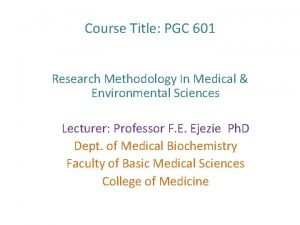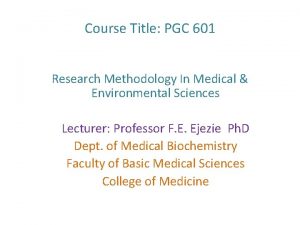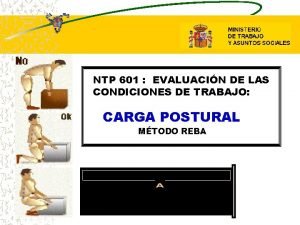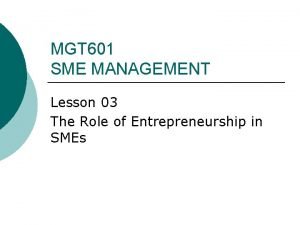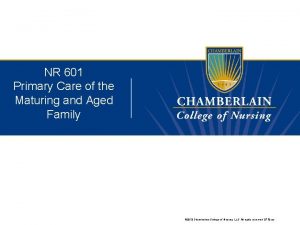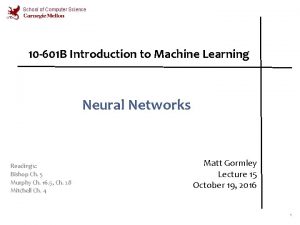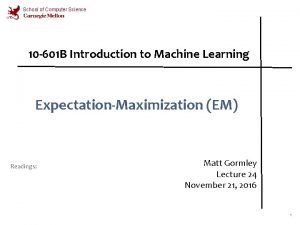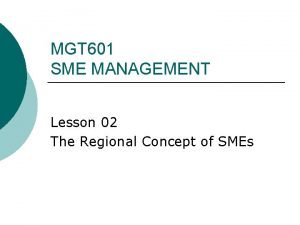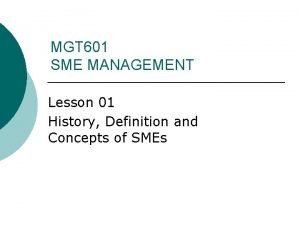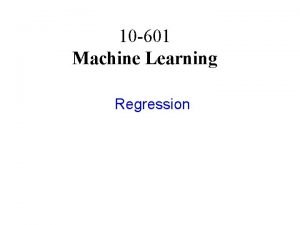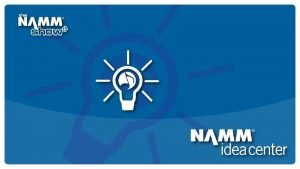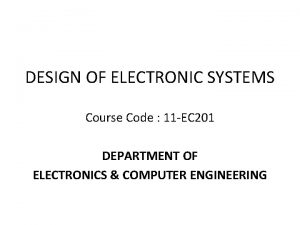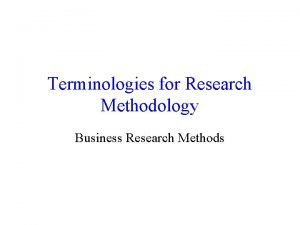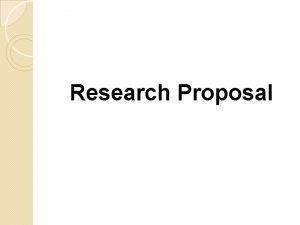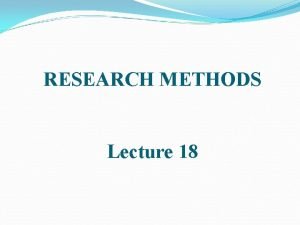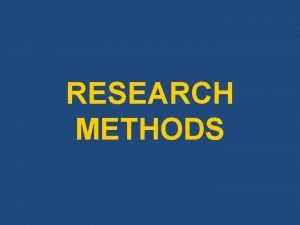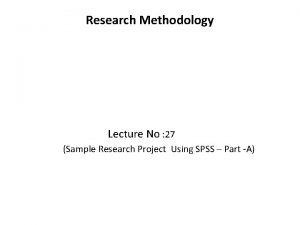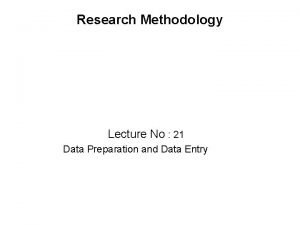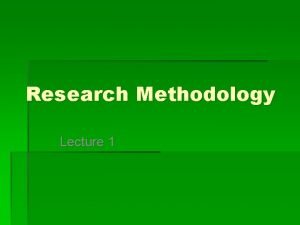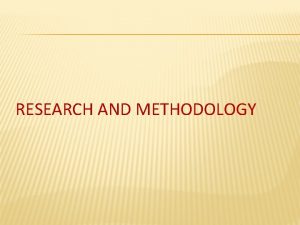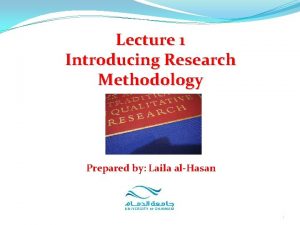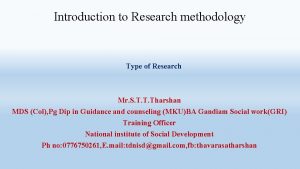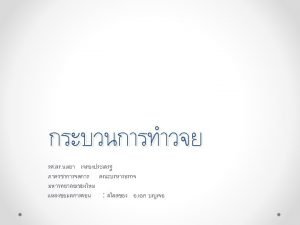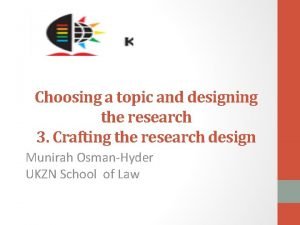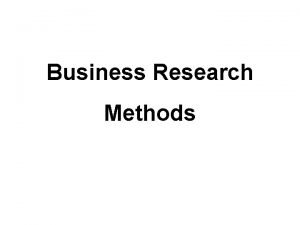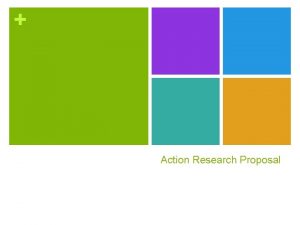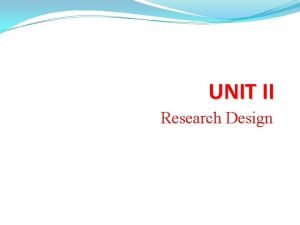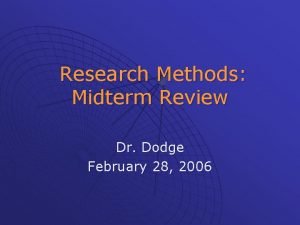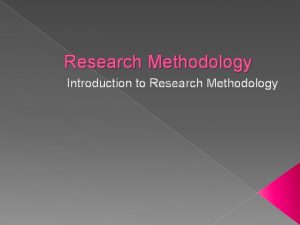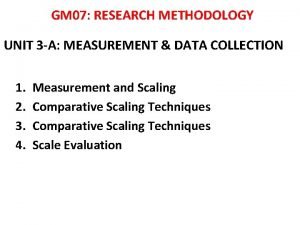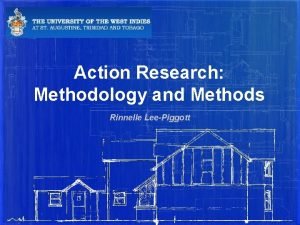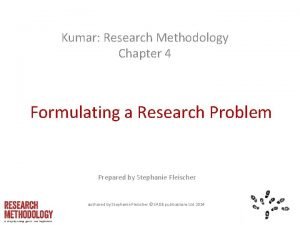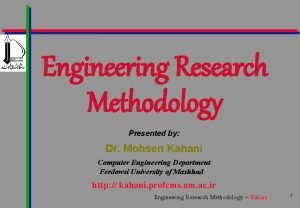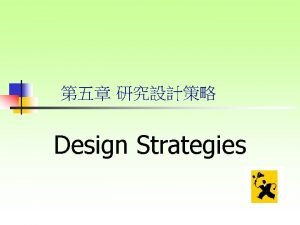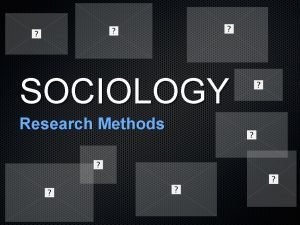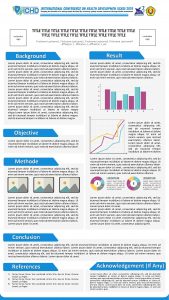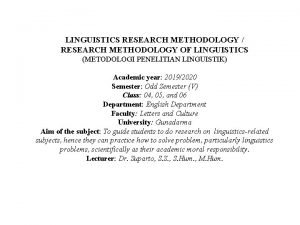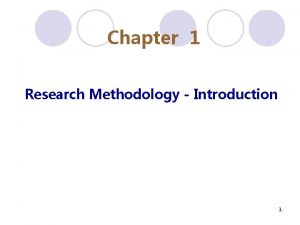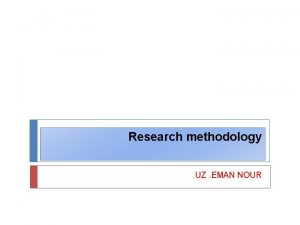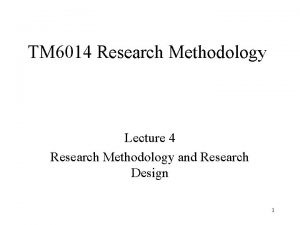Course Title PGC 601 Research Methodology In Medical
































































- Slides: 64

Course Title: PGC 601 Research Methodology In Medical & Environmental Sciences Lecturer: Professor F. E. Ejezie Ph. D Dept. of Medical Biochemistry Faculty of Basic Medical Sciences College of Medicine

Introduction • Search: To search is to examine something thoroughly; to look into or over something carefully – to look for information • Research: To research is to search again; to examine further – to look for further information • Research: A methodical investigation into a subject in order to discover/establish more facts or information

What is Research? • There has been a continuous search for knowledge by man • But gaps still remain; • many questions still remain unanswered; • many problems remain unsolved Definition: Research may be defined as a systematic search for new facts, new knowledge and getting additional information. It involves the identification of a problem and proffering solutions through planned and systematic collection, analysis and interpretation of data.

Research Areas • • • Research is obtained in ALL disciplines Health research/Medical research Research in the Environmental Sciences Research in the Social Sciences Research in the Natural Sciences Arts Engineering Agriculture Multi-disciplinary research etc

The Process of Research (Major Steps) • The process is initiated with a question or problem (step 1) • Next, goals and objectives are formulated to deal with the question or problem (step 2) • Then the research design is developed to achieve the objectives (step 3) • Results are generated by conducting the research using specific methods (step 4) • Interpretation and analysis of results follow (step 5)

The Process of Research 1 2 5 4 3

Biomedical Research • This refers to health related research • What is health? – Health is a state of complete physical, mental and social well being and not just the absence of diseases or infirmitities. • Objectives of health-related research -To promote and protect well being of man so as to attain and sustain an optimal quality of life -To prevent diseases at all levels – 1 o, 2 o, 3 o levels

Environmental Research • Environmental science is the academic field that takes physical, biological and chemical sciences to study the environment and discover solutions to environmental problems. • Objectives of environmental research : • To recognize that environmental problems such as climate change, global warming, ozone layer depletion, acid rains, and impacts on biodiversity and marine life • To protect the environment and human health through improved sanitation, hygiene, health education, and reduce the burden of infectious diseases

Environmental Research (objectives contd) • To study of interaction between human systems (the population) and natural systems (the earth and life) • To understand the impacts of development on environment • To discover sustainable ways of living • To utilize natural resources efficiently • to help protect and preserve the environment

Application of Research • Research reports are used (pre-requisite) in the award of – Degrees – Diplomas – Fellowships – Certificates – Promotion – Improvement of quality of human life And development in different spheres of life

Characteristics of Research A good research requires the following: • Clear statement of the problem and purpose • A good plan (study design) • Knowledge of existing data/information • Organised collection of new data

Types of Research There are two main types: • Basic research – eg determination of causes and risk factors of diseases; comparison of treatment regimens or chemotherapy • Applied Research – eg Evaluation of health policies, programmes etc

Basic research • Basic – to determine or establish fundamental facts and relationships within a discipline or field of study. It is usually considered to involve the search for knowledge without a defined goal of utility or specific purpose. • E. g. The microbiologist, whose expertise is the identification of pathogenic microorganisms may conduct research in-vitro, in a laboratory on bacterial reproduction, growth and endotoxin production without any direct application to clinical medicine. Probably, the researcher is interested in monitoring endotoxins produced over the life cycle of bacteria to determine its pathogenecity.

Applied Research • Applied – undertaken specifically for the purpose of obtaining information to help resolve a particular problem • It is problem oriented and is directed towards a defined and purposeful end. • Eg. An oral health researcher investigating the relationship between periodontal disease and myocardial infarction may use the findings of the microbiologist as a theoretical framework to test the relationship between bacterial endotoxins, periodontal disease and myocardial infarction in animal and then in human subjects

Distinction between Basic and Applied Research • The distinction between them is in the application - Basic has little application to real world policy and management but could be done to guide applied research - Basic research is usually considered to involve the search for knowledge without a defined goal of utility or specific purpose unlike applied research.

Research Project • This is a well structured process with set rules for carrying it out, which all researchers must be conversant with and adhere to. • It is conducted in a logical manner with relevant references. • Benefits of Research Project include the provision of necessary information to improve the quality of human life generally

Stages of a Research Project • • Problem identification Prioritization Development of a project title Statement of the problem Review of existing literature Formulation of research objectives Hypothesis framing Selection of research method (s)

Stages of a Research Project cont’d • Selection of subjects • Collection of data • Data analysis • Result presentation • Discussion • Conclusion & recommendation • Compilation of references • Appendix • Report writing The stages must not be followed strictly in this order

Problem Identification • Investigator must identify a problem whose solution requires research • A problem could be identified through: v review of literature (vast reading) vobservation of events v discussions/consultations with older researchers The problem identified in one study could unfold another research topic

Prioritization • There are usually more than one problem at any given time • Limited resources/duration (time) may not allow all problems to be handled at the same time • Factors used for setting up priority of the problems identified include: -Feasibility, relevance, avoidance of duplication, need/urgency of need, cost effectiveness, ethical acceptability, time, manpower, materials/equipment, replication, application/implementation of results, interest of investigator.

Development of Project Title • This gives focus and scope of the project being formulated • Title may not be concluded at the initial stages • May change as the project progresses • (for UNN, approval of title/synopses is the final step in Ph. D projects)

Literature Review • This is a very important aspect of project formulation • May be continuous throughout the project execution • Helps to find available information on the topic • Should be extensive and focused • Helps to know what others have done or reported

Literature Review cont’d • Prevents duplication • Identifies contested issues • Provides facts for the justification of research project • Helps in formulation of objectives and research questions • Provides a guide for choice of methods, sample size, & statistical analysis (design)

Sources of Literature • Interview: name of interviewer, and date of interview (Interaction with researchers in the area). • Books: author(s), book title, publisher, date of publication, and page number(s) if appropriate. • Journals: author(s), article title, journal title, date of publication, and page number(s). • Abstracts • Newspapers/magazines: author(s), article title, name of newspaper, section title and page number(s) if desired, date of publication.

Sources of Literature cont’d Technical reports Conference proceedings Thesis reports Indexes – eg Index Medicus (Nat. Lib. of Medicine USA) • Web sites: author(s), article and publication title where appropriate, as well as a URL, and date when the site was accessed (internet searches). • Most of these are found in Libraries • •

Statement of Problem(Justification) • Enables researcher to systematically point out what the problem is • Why the problem should be solved • What is to be achieved by doing so • It justifies the study. • A good literature search is very useful in the statement of problem.

Research Objectives(Aims) • Means what the research/researcher wishes to achieve/accomplish • Should facilitate the development of methods • Should be specific- action verbs are to be used eg to determine, identify, verify, calculate, describe, reduce, identify, compare, measure. . . . etc (no ambiguity)

Research Objectives(Aims) cont’d • Should be measurable- avoid such verbs as : to appreciate, understand , believe, realise. . . . etc • Should be achievable/practicable • Should be realistic • Should be time-bound • May be put into: general and specific objectives

Hypothesis • Is a prediction of a relationship between two or more variables and the problem under study • Data analysis tests this supposition • Interpretation of data will either disprove (reject) or support (uphold) the hypothesis • Hypothesis translates the problem statement into a precise, unambiguous prediction of expected outcomes

Hypothesis (2) • It should be stated in testable terms • Conventionally stated as “null hypothesis” – which states that there is no difference b/w groups or no association b/w variables • Hypothesis may also be stated as a positive declaration

Hypothesis Framing • Ways to Express Hypotheses: (no association) • Suggest No relationship between specific exposure and health-related events… • A high cholesterol intake is not associated with the development (risk) of coronary heart disease.

Hypothesis Framing (2) • Ways to Express Hypotheses: (positive declaration) • Suggest cause-effect relationship…. • Cigarette smoking is a cause of lung cancer

Research Method &Research Methodology and Method are often (incorrectly) used interchangeably. Research Method is a step in a Research process or Methodology • Methodology – the study of the general approach to inquiry in a given field (sciences, arts, law, humanities etc).

Research Methods (1) • Method s– the specific techniques, tools or procedures applied to achieve a given objective. Here the research or study design is laid out. - Science – involves the Lab, equipment, animals, humans, chemicals, other tools. (Materials/patients and methods) – Research methods in economics include regression analysis, mathematical analysis, operations research, surveys, data gathering, etc.

Research Methods (2) • The choice of a research method depends on: – Research Questions – Research Goals – Researcher Beliefs and Values – Researcher Skills – Time and Funds • A research method shows how the study is designed

Research Methods (3) • The method to be used in a study may be Ø Qualitative – descriptive in nature eg Case study, participatory action research , data gathering etc Ø Quantitative – involves experiments/measurements, observations or surveys Ø Mixed Methods - draw from qualitative and quantitative methods

Ethical Considerations In Health Research • To protect humans and animals from possible abuses • Involves use of humans subjects/animals in research and clinical trials • Use of human subjects makes animal studies clinically useful • Risk is justified in terms of benefits and contribution to human knowledge • Aims to improve quality of life • To prolong life of human

General Ethical Principles Respect for the human person Ensure no harm to human subjects used Maximum benefits and minimum harm Ensure justice – equal treatment to all Ensure respect for privacy and human dignity Informed consent (verbal or written) must be obtained – parents for minors/pregnancy • Qualified personnel is involved • Ethical Committee Certificate must be obtained • • •

Subject Selection (1) • This is dependent on some factors: – Level of precision desired – Type of study design – Prevalence of condition from previous studies – Available time and funds – Personnel – Inclusion & exclusion criteria stated

Sampling techniques ü Simple random - eg lucky dip ü Systematic random - eg even nos, odd nos etc ü Stratified random ü Cluster ü Multi-stage etc

Sample Size Estimation • Sample size should be large enough for -appropriate analysis - desired level of accuracy - validity of significant tests - confidence level • On the basis of the above considerations, the researcher can calculate the sample size needed • Different formulae are given/used on different settings

Sample Size Estimation (eg 1) • For populations greater than 10, 000 n = z 2 pq/d 2 where: n = desired sample size (population greater than 10, 000) z = normal standard deviation usually set at 1. 96 (or more simply at 2. 0) which corresponds to the 95% confidence level p = the proportion in the target population estimated to have a particular characteristic. If there is no reasonable estimate, then use 50% (ie 0. 50) q = 1. 0 - p 0. 02

Sample Size Estimation (eg 2) • For populations less than 10, 000 nf = n/1+(n)/(N) • Where: – nf = the desired sample size when population is less than 1, 000 – n = the desired sample size when population is more than 1, 000 – N = the estimate of the population size

Sample Size Estimation (eg 3) • Sample size for comparison groups (eg test and control) where: n = 2 z 2 pq/d 2 n = desired sample size for comparison groups (equal in test and control groups) z = normal standard deviation usually set at 1. 96 (or more simply at 2. 0) which corresponds to the 95% confidence level p = the proportion in the target population estimated to have a particular characteristic. If there is no reasonable estimate, then use 50% (ie 0. 50) q = 1–p If you cannot assume equal sub-sample sizes or if the sizes of the populations from which the samples are drawn are much less than 1, 000, the procedure for sample size estimation may become more complicated. In such and other cases, please consult a statistician.

Sample Size Estimation • In all, a large sample size will yield more accurate results but may be more costly than a smaller sample size.

Sampling Method - Probability Method – Simple Random – Table of Random numbers, Basket method – Systematic method – may be random but systematic – Stratified method – stratification by characteristics b 4 selection – Multistage method – for large scale surveys. Selection done in stages – Cluster method – population first divided into heterogeneous clusters eg families, villages, tribes, level of education etc

Sampling Method - Non-Probability method • (not based on known probabilities) – Convenience (also haphazard/accidental) – Quota – pre-determined eg based on sex, age, ethnic group etc – Judgemental (also purposive – investigator believes or presumes that samples are good representation of population for study) eg some states as representation of Nigerian population – Snowball - Data is collected from a small group of people with same the characteristics. This group then assists to identify other people like them. This continues in turns, until the required sample size is attained.

Data Collection • There are 2 major types – Quantitative data – Qualitative data – study design determines mode of data collection – based on variables to be measured

Quantitative data • Obtained from measures of quantity or frequency • Obtainable from: questionnaires interviews experimental results observations, diaries etc

Qualitative data • Collected from social surveys • Recorded in prose form • Obtained from: ü group interviews ü focus group discussions (FGDs) ü telephone interviews ü face to face interviews ü In-depth and key informant interviews etc

Data Processing –PROFESSOR AGUWA E.

Discussion • Major findings in the research are outlined and discussed • May also mention findings from other related studies • References and comparisons are made to past knowledge and reports • Inferences are also drawn from the results/data • Major contributions to knowledge are stated • Limitations of the study may also be discussed

Conclusions/Recommendations • The findings in relation to the research questions and/or objectives are summarized as conclusion • Recommendations are made based on research results/data and the problem the research project is addressing • Recommendations should follow logically from the discussion of the findings

References • There are different reference styles – The Vancouver system – Harvard system – American Psychological Association (APA) system – American Chemical Society (ACS) style – American Mathematical Society (AMS) style etc – Institute of Electrical &Electronics Engineers (IEEE) system The Vancouver system, recommended by the Council of Science Editors (CSE), is used in medical and scientific papers and research. Style may vary from institutions, faculties, departments etc

Journal References • If authors’ names are used in the text, followed by year of publication in brackets (eg. Ejezie, 2011); (Onyekwelu, et al 2017) – the references should be listed in alphabetical order by authors’ last names. • Ejezie F. E, Nwagha U. I. Zinc concentrations during pregnancy and lactation in Enugu, South-East Nigeria. Annals of Medical and Health Sciences Research. 2011. 1(1): 69 -76. • Onyekwelu , K. C. , Ejezie, F. E. , Eze, A. A. , Ikekpeazu , J. E. , Isaac , C. , Ibegbu , D. M. , Ogbunude , P. O. J. Molecular Identification of Trypanosomes in Tsetse Flies trapped from Onicha Ugbo in Delta State of Nigeria. Biomedical Research. 2017. 28(12): 5463 – 5467. • Any style used must be consistent

Book References • Ejezie, F. E. & Ikekpeazu, J. E. (2017). Fundamentals of Metabolism. (2 nd edition). Enugu. Ezu Books Ltd. pp 150 -163. • Pegrum, M. (2009). From blogs to bombs: The future of electronic technologies in education. Crawley, W. A: UWA Publishing. pp 78 – 82.

Online (Website) Reference • Citing a general website article with an author Author, A. (Year of Publication). Article title. Retrieved from URL, date retrieved. • Australian Environmental Society (2007). Improve indigenous housing now, government told. . http: //www. architecture. com. au/icms? page=10220 (retrieved 20 th Sept. 2007).

Appendix • For additional information and contains: – Raw data – Relevant tables/graphs used in the project design – Relevant pictures - eg plants used in study, special equipment – Documents eg ethical committee certificate – Items help to clarify issues in research report – Items help to authenticate/validate research process – Numbered in Roman numerals – I, III, IV etc – May be optional in some cases

Dissemination • Research report is written for: – Presentation/examination – Publication in peer-reviewed journals

Format for Research Report – Preliminary pages • • Title or cover page Certification page Dedication Acknowledgement Abstract or summary Table of contents List of tables, figures List of abbreviations

Format for Research Report – Main Report Sequence • • • Introduction Objectives Literature review (Justification) Materials/patients and methods Results Discussion Conclusion Limitations(if any) Recommendations References Appendix

Chapters of Research Project Report • • Chapter 1 – Introduction/objectives Chapter 2 – Literature review Chapter 3 - Materials & Methods Chapter 4 - Results Chapter 5 – Discussion Chapter 6 - Conclusion & Recommendations References Appendix

References • Creswell, J. W. (2003). Research design qualitative, quantitative and mixed methods approaches. Sage publications London. 2 nd Ed. p. 19 https: //ucalgary. ca/paed/files/paed/2003_creswell_a-framework-fordesign. pdf (retrieved 12/7/17) • Denzin , N. K. , Lincoln, Y. S. (2000). Handbook of Qualitative Research. 2 nd ed. Sage publications • Johnson, G. L. (1986). Research Methodology for Economists: Philosophy and Practice. Macmillan, New York. pp 11 – 27 • Research and Methodology (2014) - University of Hawaii at Manoa: Lecture 2 slides. www. manoa. hawaii. edu/ctahr/aheed/. . . /Lecture 2_Research_&_Methodol ogy_Chap 2. (retrieved 23/4/16) • Saunders, M. , Lewis, P. & Thornhill, A. (2000). Research methods for business students. 2 nd edition. Harlow: Pearson Education. • Onwasigwe, C. N. (2004). Medical Research Project: A Practical Guide. Enugu. El ‘Demak Publishers.

Thank You
 Pgc 601
Pgc 601 Pgc 601
Pgc 601 Pgc 601
Pgc 601 Pgc 601
Pgc 601 Course number and title
Course number and title Pgc 2000
Pgc 2000 601 s belvidere st richmond va
601 s belvidere st richmond va Ek 601
Ek 601 Ntp reba
Ntp reba Mgt 601
Mgt 601 Http 601
Http 601 Nr 601 test bank
Nr 601 test bank 601(b)(10)
601(b)(10) 601(b)(10)
601(b)(10) Sme management definition
Sme management definition Deffibrilator
Deffibrilator Usine peugeot
Usine peugeot Tcp 601
Tcp 601 Hino 601
Hino 601 601(b)(10)
601(b)(10) Club 601
Club 601 Sme management definition
Sme management definition Linear regression loss function
Linear regression loss function Prefatory elements
Prefatory elements Title title
Title title Facebook marketing examples
Facebook marketing examples Course title
Course title T junction of stretcher bond
T junction of stretcher bond Course interne moyenne externe
Course interne moyenne externe Ualitative data
Ualitative data Objective in research
Objective in research Paradigm vs model
Paradigm vs model Objectives in research methodology
Objectives in research methodology Research methodology flow chart
Research methodology flow chart How to write methodology in research proposal
How to write methodology in research proposal Criteria for good measurement in research methodology
Criteria for good measurement in research methodology What is dimensions in research
What is dimensions in research Methodology vs. method
Methodology vs. method Project proposal methodology sample
Project proposal methodology sample Central editing in research methodology
Central editing in research methodology To gain familiarity with a phenomenon
To gain familiarity with a phenomenon Examples of continuous variables
Examples of continuous variables Variable in research methodology
Variable in research methodology Ocjs grants
Ocjs grants Objectives of research methodology
Objectives of research methodology Ftpay
Ftpay Purpose of the study
Purpose of the study Define data collection method
Define data collection method Design research methodology
Design research methodology What are the components of chapter 3 in research
What are the components of chapter 3 in research Types of research methodology
Types of research methodology Factor analysis
Factor analysis How to write methodology in research proposal
How to write methodology in research proposal Ocar structure
Ocar structure Confounded relationship in research methodology
Confounded relationship in research methodology Research methodology lecture notes doc
Research methodology lecture notes doc Research methods midterm
Research methods midterm Methodology in research
Methodology in research Constant sum scale in research methodology
Constant sum scale in research methodology Methodology in research
Methodology in research Differences between exploratory and conclusive research
Differences between exploratory and conclusive research Formulating research methodology
Formulating research methodology Engineering research methods
Engineering research methods Research methodology secondary data example
Research methodology secondary data example True or false questions on research methodology
True or false questions on research methodology

